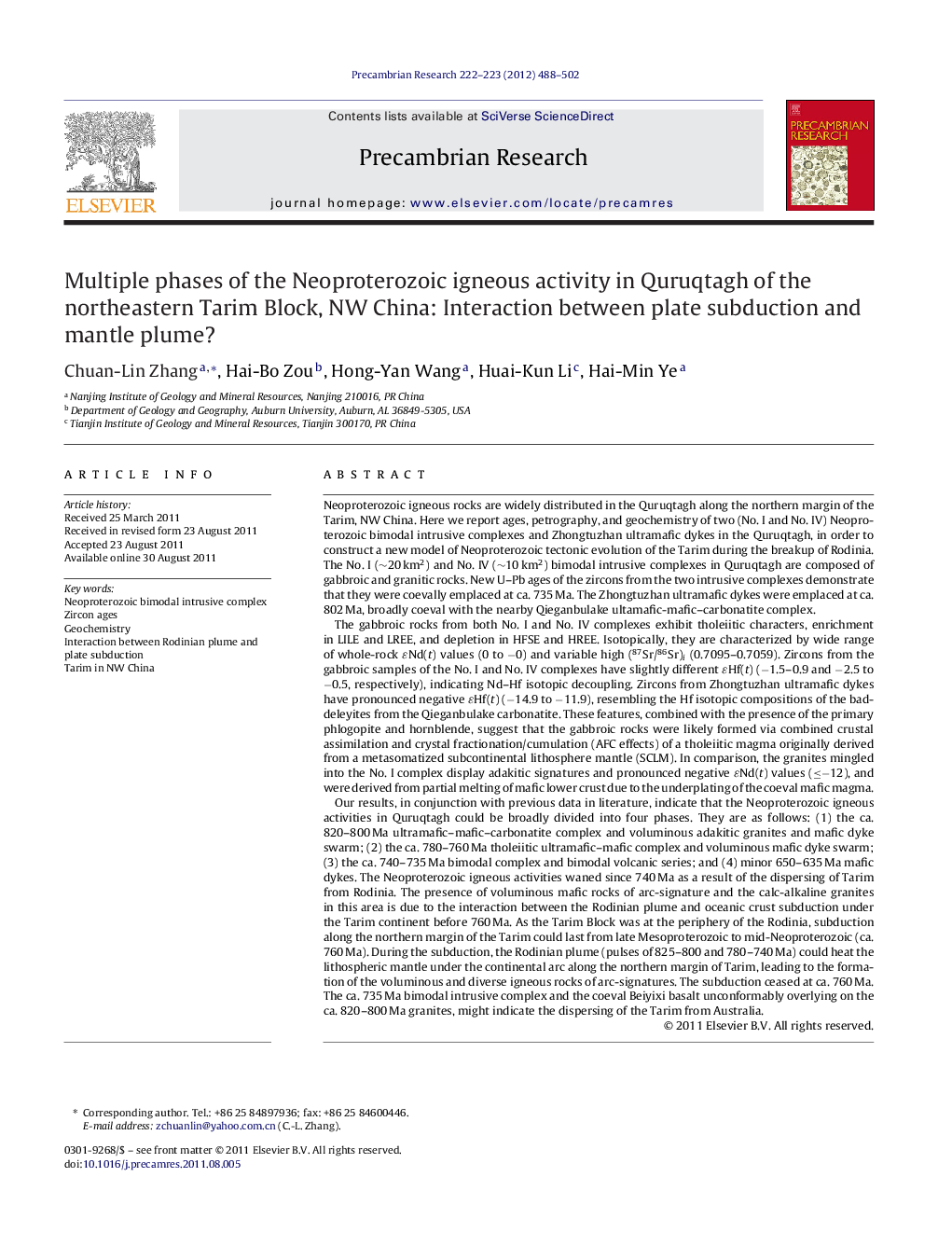| کد مقاله | کد نشریه | سال انتشار | مقاله انگلیسی | نسخه تمام متن |
|---|---|---|---|---|
| 4723464 | 1639651 | 2012 | 15 صفحه PDF | دانلود رایگان |

Neoproterozoic igneous rocks are widely distributed in the Quruqtagh along the northern margin of the Tarim, NW China. Here we report ages, petrography, and geochemistry of two (No. I and No. IV) Neoproterozoic bimodal intrusive complexes and Zhongtuzhan ultramafic dykes in the Quruqtagh, in order to construct a new model of Neoproterozoic tectonic evolution of the Tarim during the breakup of Rodinia. The No. I (∼20 km2) and No. IV (∼10 km2) bimodal intrusive complexes in Quruqtagh are composed of gabbroic and granitic rocks. New U–Pb ages of the zircons from the two intrusive complexes demonstrate that they were coevally emplaced at ca. 735 Ma. The Zhongtuzhan ultramafic dykes were emplaced at ca. 802 Ma, broadly coeval with the nearby Qieganbulake ultamafic-mafic–carbonatite complex.The gabbroic rocks from both No. I and No. IV complexes exhibit tholeiitic characters, enrichment in LILE and LREE, and depletion in HFSE and HREE. Isotopically, they are characterized by wide range of whole-rock ɛNd(t) values (0 to −0) and variable high (87Sr/86Sr)i (0.7095–0.7059). Zircons from the gabbroic samples of the No. I and No. IV complexes have slightly different ɛHf(t) (−1.5–0.9 and −2.5 to −0.5, respectively), indicating Nd–Hf isotopic decoupling. Zircons from Zhongtuzhan ultramafic dykes have pronounced negative ɛHf(t) (−14.9 to −11.9), resembling the Hf isotopic compositions of the baddeleyites from the Qieganbulake carbonatite. These features, combined with the presence of the primary phlogopite and hornblende, suggest that the gabbroic rocks were likely formed via combined crustal assimilation and crystal fractionation/cumulation (AFC effects) of a tholeiitic magma originally derived from a metasomatized subcontinental lithosphere mantle (SCLM). In comparison, the granites mingled into the No. I complex display adakitic signatures and pronounced negative ɛNd(t) values (≤−12), and were derived from partial melting of mafic lower crust due to the underplating of the coeval mafic magma.Our results, in conjunction with previous data in literature, indicate that the Neoproterozoic igneous activities in Quruqtagh could be broadly divided into four phases. They are as follows: (1) the ca. 820–800 Ma ultramafic–mafic–carbonatite complex and voluminous adakitic granites and mafic dyke swarm; (2) the ca. 780–760 Ma tholeiitic ultramafic–mafic complex and voluminous mafic dyke swarm; (3) the ca. 740–735 Ma bimodal complex and bimodal volcanic series; and (4) minor 650–635 Ma mafic dykes. The Neoproterozoic igneous activities waned since 740 Ma as a result of the dispersing of Tarim from Rodinia. The presence of voluminous mafic rocks of arc-signature and the calc-alkaline granites in this area is due to the interaction between the Rodinian plume and oceanic crust subduction under the Tarim continent before 760 Ma. As the Tarim Block was at the periphery of the Rodinia, subduction along the northern margin of the Tarim could last from late Mesoproterozoic to mid-Neoproterozoic (ca. 760 Ma). During the subduction, the Rodinian plume (pulses of 825–800 and 780–740 Ma) could heat the lithospheric mantle under the continental arc along the northern margin of Tarim, leading to the formation of the voluminous and diverse igneous rocks of arc-signatures. The subduction ceased at ca. 760 Ma. The ca. 735 Ma bimodal intrusive complex and the coeval Beiyixi basalt unconformably overlying on the ca. 820–800 Ma granites, might indicate the dispersing of the Tarim from Australia.
► Petrography, ages and systematic geochemical data of the Neoproterozoic bimodal intrusive complex from the northern margin of Tarim, NW China.
► Four phases of Neoproterozoic igneous activity are determined, i.e., ca. 820–800 Ma; ca. 780–760 Ma; ca. 740–735 and 650–635 Ma.
► A new tectonic evolution model from assemblage at early Neoproterozoic to the breakup of the Rodinia at late Neoproterozoic, as well the possible interactions between plate-subduction and mantle plume, are constructed.
Journal: Precambrian Research - Volumes 222–223, December 2012, Pages 488–502